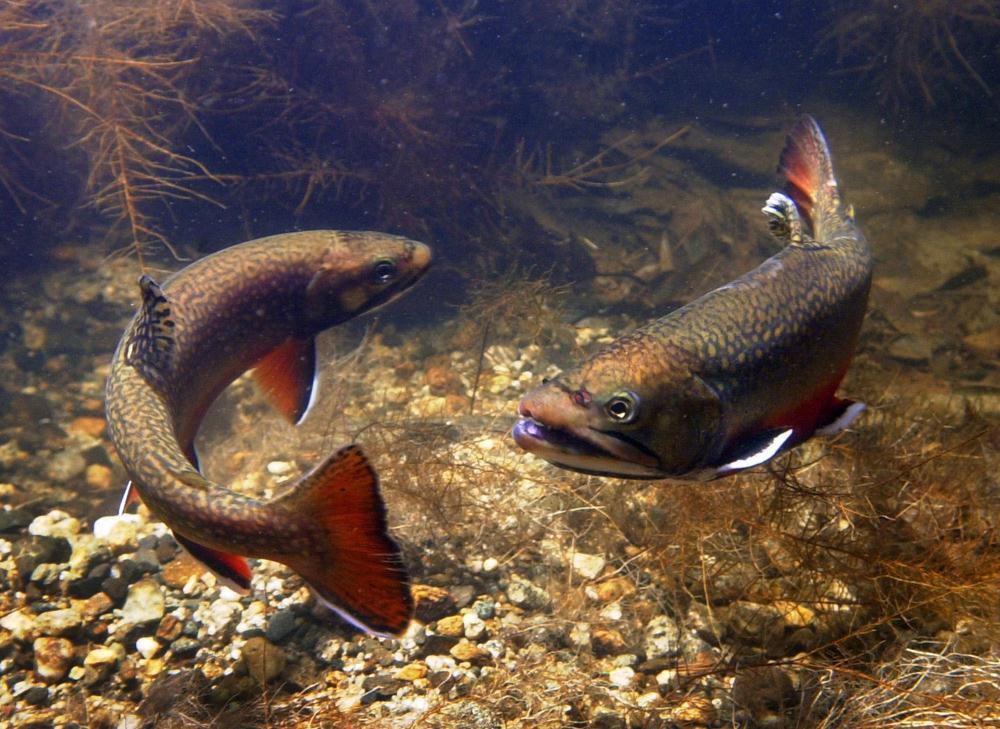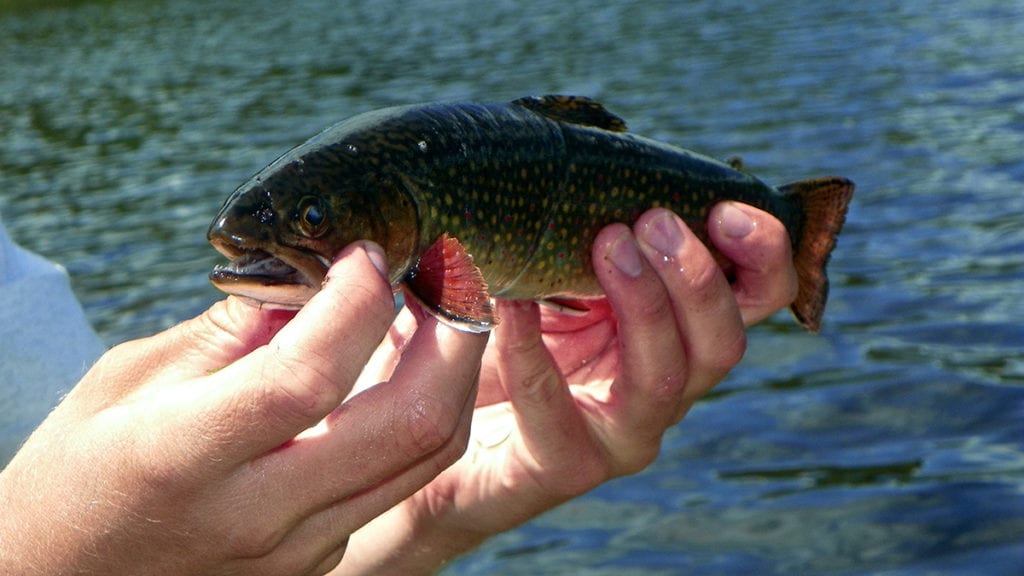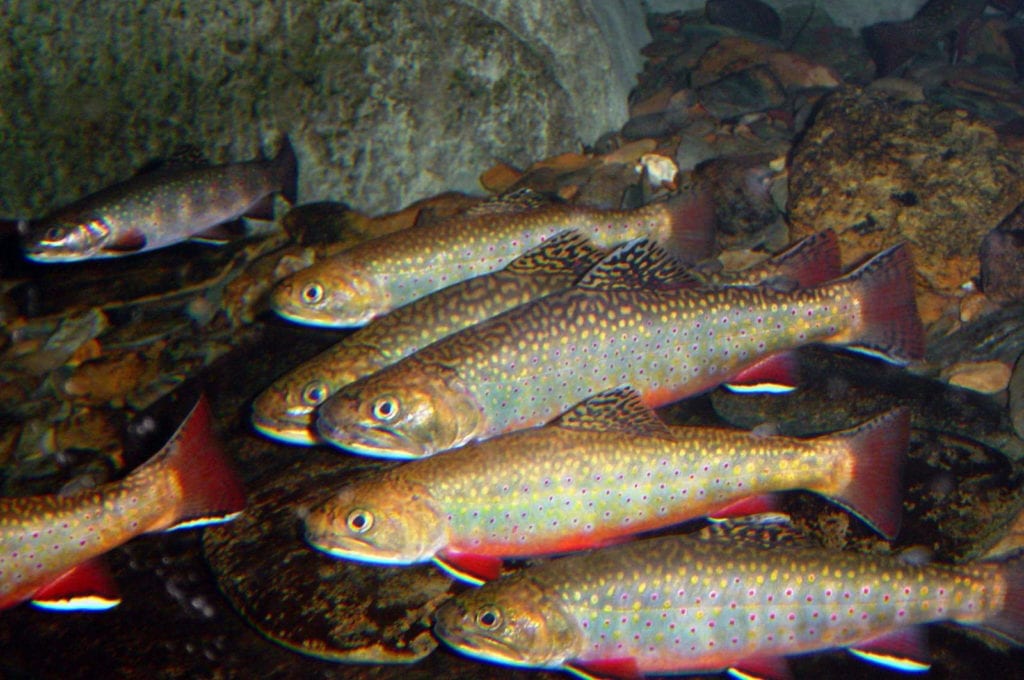
Thanks to the hard work of hundreds of volunteer anglers, the Heritage Waters Work Group, the Maine Department of Inland Fisheries and Wildlife, and the many people who attended public informational meetings and hearings, most Brook Trout in northern Maine will soon have one less thing to worry about: the introduction of live bait fish into their native waters.
Last week the Department’s Advisory Council approved rules that will proactively restrict the use of live fish as bait from being used in all lakes, ponds and streams in the North Zone, with exceptions granted for those waters with a long history of ice fishing with bait or where nonnative fish have already become established. Soon they will be considering similar rules for a smaller number of Brook Trout ponds, lakes and tributaries in the South Zone as well.
The idea of adopting “no live fish as bait” in general rule for most waters in the North Zone was presented to the Heritage Waters Work Group in 2018 and strongly endorsed in concept by everyone in the Work Group, including Maine Audubon. We agreed that taking this proactive, watershed-based approach was strongly preferable to our current system because it will reduce the risk of introducing non-native bait fish and other fish that are not already present in waters inhabited by heritage fish.

Because Maine is the last stronghold for eastern Brook Trout in the nation, and the only eastern state with natural populations of both Atlantic Salmon and Arctic Charr, we have both an opportunity and a responsibility to do all we can to protect these remaining fish and their cold water habitats. The proposal has the added benefit of streamlining the fishing regulations booklet and the job of game wardens to enforce those rules throughout the North Zone, and appears to have little impact on the bait industry.
We applaud the Department for taking this step and adopting these rules, which will go into effect in January 2020. Based on public comments received at multiple informational meetings, the two rule-making hearings, and submitted in writing, it is clear that the vast majority of anglers, bait fishermen, and other interested parties also support the shift. Some even urged the Department to go further and do more. We’d like to see that too, and stand ready to help.
You can help our wild Brook Trout by adhering to the new rules and telling all your angling buddies about them as well. For more details, please continue reading and check out the 2020 fishing rules book in January!
Additional Information:
Maine’s native and wild Brook Trout populations represent a unique and abundant resource not available elsewhere in the United States. Maine contains over 50% of the nation’s remaining population, 97% of all the wild or native Brook Trout ponds, and an estimated 22,248 miles of stream habitat. This makes Maine the last true stronghold for wild Brook Trout and the only state with extensive intact populations of self-reproducing Brook Trout in lakes and ponds, and supports the only populations of native, wild Arctic Charr remaining in the contiguous United States.
While significant pressures continue to threaten Brook Trout across their range, Maine’s wild Brook Trout waters are still in pretty good shape, and represent a unique, valuable and irreplaceable ecological resource. Because Maine is at the northern edge of the Brook Trout’s range, Maine is predicted to be one of the last best places (other than Appalachia) to find and fish for Brook Trout as the climate warms. Through proper identification and regulation, waters can be protected so wild Brook Trout thrive in the future.
That’s why Maine Audubon teamed up with Trout Unlimited and Maine Department of Inland Fisheries and Wildlife to enlist the help of anglers to search for wild Brook Trout in remote ponds and coastal streams. (Read this account from Maine Guide Ronald Dupuis about surveying for rare “Salter” Trout) Between 2011-2018, 423 anglers contributed 8,635 volunteer hours to survey 464 remote ponds that had never been surveyed before and 208 coastal streams to search for sea-run Brook Trout. They found Brook Trout in 82 ponds and 90 streams; MDIFW confirmed breeding populations of brook trout in 58 of those ponds and added 30 of them to the Heritage Fish Waters List. More could be added in the future.

That’s also why the Heritage Waters Work Group, which Sally Stockwell from Maine Audubon served on, worked closely with the MDIFW to find ways to expand protection for Brook Trout and Artic Charr beyond the several hundred ponds that had already been identified as Heritage Waters due to the presence of a multi-aged breeding population of wild trout. Heritage Waters are ponds and lakes that have self-sustaining populations of Brook Trout and/or Arctic Charr and have never been stocked or not stocked in the past 25 years, and do not allow stocking or use of live fish as bait.
However, fish need to move, often traveling up and down stream and from pond or lake to stream to find the food, spawning habitat, nursery areas, and cold-water refuges they need throughout the year, so designating only Heritage Waters – or the “cream of the crop” breeding populations – as places where neither live fish as bait or stocking can occur – misses important parts of the population or life cycle of these wild fish.
The Work Group recognized the importance of acting proactively to protect this unique national resource, and ultimately came up with this new approach. The Work Group agreed that across Maine we need to, among other things: (1) minimize threats from inter and intraspecific competition associated with new introductions of fish, including illegal introductions, MDIFW stocking, private stocking, and collection, storage and use of live bait fish and (2) minimize other threats associated with environmental and land based activities that pose direct and indirect threats to heritage fish, their habitat and food source.
